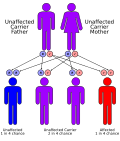Arterial tortuosity syndrome: Difference between revisions
CSV import |
CSV import |
||
| Line 53: | Line 53: | ||
[[Category:Rare diseases]] | [[Category:Rare diseases]] | ||
[[Category:Vascular diseases]] | [[Category:Vascular diseases]] | ||
== Arterial tortuosity syndrome == | |||
<gallery> | |||
File:autorecessive.svg|Arterial tortuosity syndrome | |||
File:Human male karyotpe high resolution - Chromosome 20 cropped.png|Arterial tortuosity syndrome | |||
File:Blausen 0350 EndoplasmicReticulum.png|Arterial tortuosity syndrome | |||
</gallery> | |||
Latest revision as of 00:49, 20 February 2025
| Arterial Tortuosity Syndrome | |
|---|---|
| Synonyms | N/A |
| Pronounce | N/A |
| Specialty | N/A |
| Symptoms | Arterial tortuosity, joint hypermobility, skin laxity, inguinal hernia |
| Complications | Aneurysm, stenosis |
| Onset | Congenital |
| Duration | Lifelong |
| Types | N/A |
| Causes | Genetic mutation in the SLC2A10 gene |
| Risks | Family history |
| Diagnosis | Genetic testing, clinical evaluation |
| Differential diagnosis | N/A |
| Prevention | N/A |
| Treatment | Surgical intervention, symptomatic management |
| Medication | N/A |
| Prognosis | N/A |
| Frequency | Rare |
| Deaths | N/A |
Arterial Tortuosity Syndrome (ATS) is a rare genetic disorder characterized by the elongation and tortuosity of the arteries. This condition is associated with mutations in the SLC2A10 gene, which encodes the GLUT10 protein, a member of the glucose transporter family.
Signs and Symptoms[edit]
Individuals with Arterial Tortuosity Syndrome often present with a variety of symptoms, including:
Complications can include the development of aneurysms and stenosis in affected arteries, which can lead to serious cardiovascular issues.
Genetics[edit]
Arterial Tortuosity Syndrome is inherited in an autosomal recessive manner. This means that an individual must inherit two copies of the mutated SLC2A10 gene, one from each parent, to be affected by the condition. Carriers, who have only one copy of the mutation, typically do not show symptoms.
Diagnosis[edit]
Diagnosis of ATS is based on clinical evaluation and confirmed through genetic testing. The presence of characteristic symptoms, along with a family history of the condition, can prompt genetic testing for mutations in the SLC2A10 gene.
Treatment[edit]
There is no cure for Arterial Tortuosity Syndrome, but treatment focuses on managing symptoms and preventing complications. This may include:
- Surgical intervention to correct arterial abnormalities
- Symptomatic management for joint and skin issues
See Also[edit]
References[edit]
<references group="" responsive="1"></references>
External Links[edit]
- [Genetic and Rare Diseases Information Center - Arterial Tortuosity Syndrome](https://rarediseases.info.nih.gov/diseases/107/arterial-tortuosity-syndrome)
- [OMIM Entry - #208050 - ARTERIAL TORTUOSITY SYNDROME](https://www.omim.org/entry/208050)
Arterial tortuosity syndrome[edit]
-
Arterial tortuosity syndrome
-
Arterial tortuosity syndrome
-
Arterial tortuosity syndrome


